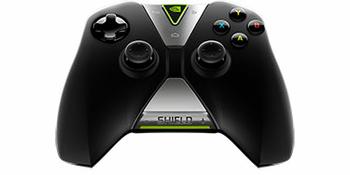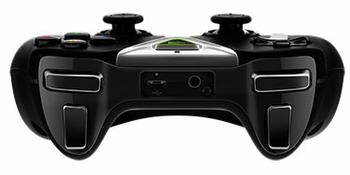Introduction
The streaming media player market has had a shot in the arm in 2015 as it's ridden off the back of popular services such as Netflix and Amazon Instant Video. These players range from the downright cheap and cheerful - think Google Chromecast - to sophisticated models promising seamless video performance at a 4K resolution and reasonable gaming credentials to boot.
Coming in at the premium end of the market, characterised by $100-plus players, is graphics stalwart Nvidia. Leveraging the know-how gained when building the handheld Shield console, Nvidia has upped the specs ante, considerably so, by shoehorning in a latest-generation Tegra X1 SoC based on the current Maxwell architecture found on desktop and mobile GeForce video cards. Supported by a custom implementation of ARM processors and sitting on top of Android TV software, this is a lot more than a vanilla streaming box.
Shield Android TV's enhanced graphics capabilities are the focal point for a streamer that straddles the financial chasm between, say, an Amazon Fire TV box and a fully-fledged console equipped with a surfeit of multimedia apps.
Shield Android TV - look, feel, and specification
Nvidia Shield Android TV specs |
|||
|---|---|---|---|
Type |
Regular |
Pro |
|
Storage |
16GB flash |
500GB HDD |
|
SoC |
Tegra X1, 256-core |
Memory |
3GB |
Storage expansion |
Micro SDXC |
Connectivity |
Bluetooth 4.1 LE 802.11ac WiFi Gigabit Ethernet 2x USB 3.0 Micro-USB |
HDMI |
2.0 (4K60) |
Android OS |
5.1 |
Dimensions |
210mm x 130mm x 25mm |
Weight |
554g (flash version) |
Price |
£149 |
£199 |
Nvidia has effectively taken the screen off a high-performance tablet and repurposed it into a deluxe media streamer. The Shield Android TV is about the same size as a large paperback book albeit, at an inch high, somewhat thinner. The chassis is home to sharp angles and a profile that rises slightly from front to back. Aesthetics verge on Marmite: you either love or loathe the look.
High-quality plastic offers good construction while a textured finish on the bottom provides solid grip. Shield TV can be mounted sideways when on an optional (£25) stand, but we prefer it in the regular orientation - it'll easily slip into any TV cabinet and, while the underlying hardware is cooled by a small fan, it's not discernible from any reasonable distance.
A discrete Nvidia logo lines the front while the shinier plastic section is lit by a subtle green LED strip whose brightness can be muted from within the control panel. Round back, keeping it modern, an SD card slot, two USB 3.0, Gigabit Ethernet, and HDMI 2.0 all appear, with the latter being important because it enables the Shield to output to a 4K TV at 60Hz.
Inside, this is a beast of a box, powered by the latest low-power mobile silicon from Nvidia. Mated to the graphics, which we'll come on to in a moment, there's a big.LITTLE cluster of eight ARM CPU cores - four Cortex-A57 and four Cortex-A53 - often seen together in premium smartphones and tablets. The real star of the hardware show is, undoubtedly, the graphics.
The Tegra X1 processor harnesses 256 cores build on the latest technology that's supported by 3GB of memory. Specs can be nebulous at the best of times, particularly for mobile, but this processor's raw power is an order of magnitude better than any other media streamer. Interestingly, for those that care, the X1 is built on a 20nm process, which is smaller and more refined than the 28nm employed on even high-end graphics such as the GeForce GTX 980 Ti.
The input devices
With less of a need to care about absolute thermals inextricably associated with a handheld device, Nvidia duly clocks the X1 GPU cores in at 1GHz, giving the complete SoC a 1TFLOP-plus rating. Yup, it's fast, and its innate speed is one of the reasons why Google itself chose the X1 for the Pixel C super-tablet.
Positioned as an Android gaming box as much as a premium media streamer, Nvidia also bundles the same WiFi controller as present on the Shield tablet. It's reminiscent of the Xbox One pad, though the d-pad is moved up top, which is no bad thing, and connects to the Shield Android TV via a protocol called WiFi Direct, used instead of Bluetooth due to its low-latency connection. Weighing in at 314g makes the Xbox One's bulky controller feel comparatively light.
Big and bold it may be, the controller is actually comfortable to use once you get used to the weight. It fits nicely into all hand sizes, intimating good ergonomics, and I had no problem in using it for extended periods without experiencing any controller-related fatigue. The combination of actual buttons and an upper-central section of capacitive buttons feels a mite strange - we don't imagine that including, say, an extra four real buttons would have made much of a difference to cost. In short, while the capacitive buttons are kind of cool at first touch, they're more style over substance.
Released in May 2015, Nvidia has supplemented both variants of the Shield Android TV by now including the previously optional remote (£40) as part of the package. This is important because Nvidia realises the Shield TV, starting at £149, needs to be perceived as more than just a capable Android-based gaming box; it also needs to work sufficiently well as a high-quality media streamer.
Build quality is, again, very good, and the small remote - 12cm long, 5cm wide - fits snugly into the palm of a hand. Like the controller, the remote has a built-in rechargeable battery that Nvidia says is good for 40 hours of usage. I had no reason to even contemplate recharging it during a week's worth of ad-hoc use. Button placement is intuitive, with the four-way circular section easy to use. The built-in mic works well when tasking Google to search for something or other and when navigating around Kodi. Handy to know that it, along with the controller, also features a headphone jack so you can listen to audio without disturbing anyone else. £40 remains too expensive as a standalone remote, meaning it's good to see Nvidia now bundle it in.







